VTU is one of the largest universities in India. It has affiliated 212 colleges as of today and offers 30 undergraduate courses. The affiliated colleges are put into categories such as
• Government
• Private aided
• Private unaided
• Minority linguistic
• Minority religious
• Autonomous
• Non-autonomous
VTU also offers management and Ph.D. programs. Currently, VajubhaiVala, Hon'ble Governor of Karnataka serves as the Chancellor, and Dr. V. Sridhar is the Vice- Chancellor of the Visvesvaraya Technological University. All the colleges in Karnataka that provide technical education are supposed to get affiliated to this university.
16 of the VTU colleges have been recognised by the World Bank under the TEQIP (Technical Education Quality Improvement Programme, a government of India initiative) Program to develop research centres, laboratories, and campus facilities.
VTU also has signed MOU’s to improve the students and teachers interaction with the industry. Some of the notable MNC’s being Microsoft, IBM, Nokia, Intel Asia Electronic Inc., Bosch Rexroth and Ingersoll-Rand (India) Ltd., Bangalore.
VTU has four regional centres in Bengaluru, Mysuru, Belagavi andKalaburangi of which Belagaviis the head quarter. To qualify for studying in VTU, a student needs to clear his/her 12th standard exam from Karnataka with a minimum of 50 per cent (40 per cent for SC, ST, and OBC). With this, he/she also has to pass the CET test.
VTU also takes lateral entry admission. Students who hold a diploma in the respective field and have scored more than 50 per cent of marks are qualified for the admission in the second year of the course.
Visvevaraya Technical University is also one of those universities that are known to use innovative technologies. They were the first to use the Digital Evaluation System during the academic year of 2011-12. They used the online services for the delivery of question papers to those colleges that are affiliated to this university.
VTU also uses modern technology for the announcement of the results and evaluation of thesis of the PG course as well as Ph.D. they also have introduced the announcement of results through SMS on the mobile phones. This university has always made the use of technology for the betterment of students, faculty as well as the system.
VTU provides the facility of eLearning to its students. They have achieved this to enhance the learning ability of the students irrespective of where they stay and at what time they want to study. This centre that was first established in Mysore in 2003 allows students to learn through EDUSAT. This innovative live video streaming lets students learn in the distant of places.
Examination details
All the affiliated colleges are supposed to take exams two times in a year. The even semester exams are conducted during May and June. The odd semester exams are to be conducted during December and January. The odd semester exam vtu results are published in the month of February while the Even semester exam results are released in the month of July.The students can avail the hall ticket and get evaluated for the online exams easily and in a hassle free manner at a central evaluation centre.






